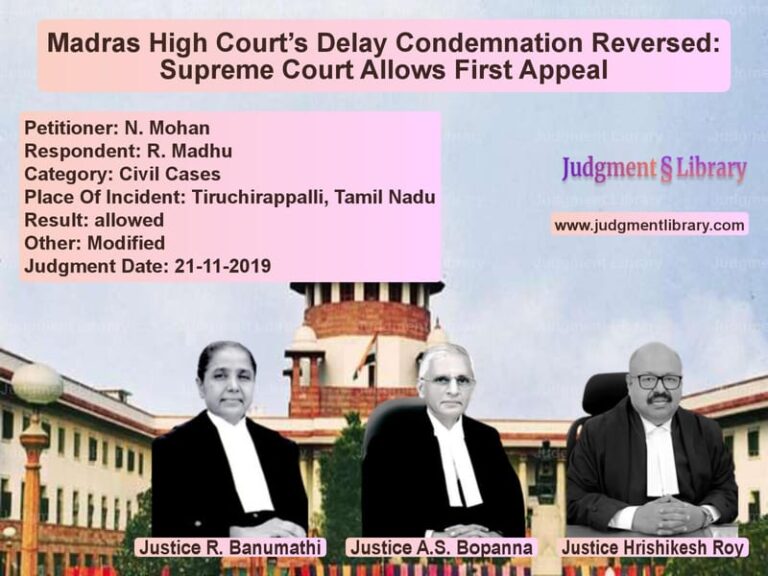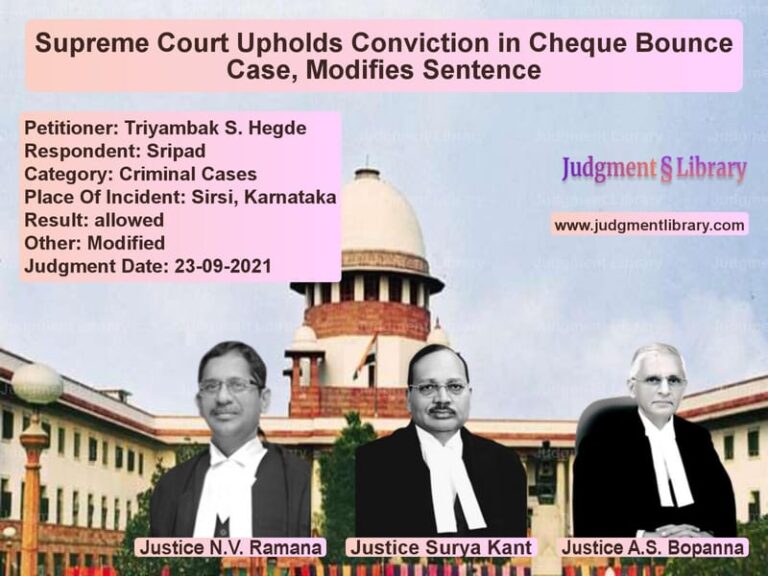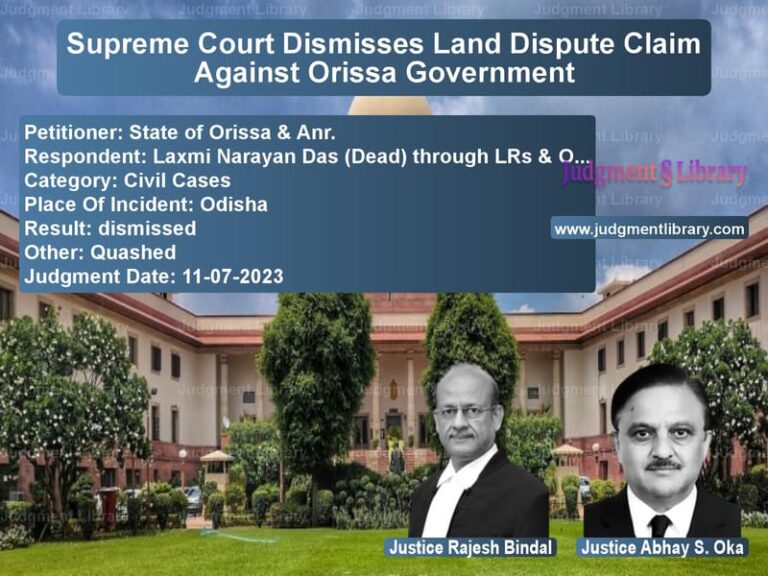NEET BDS Cut-Off Lowered: Supreme Court Directs Admission for Vacant Dental Seats
The Supreme Court of India, in a significant ruling, directed the lowering of the qualifying cut-off percentile for admission to Bachelor of Dental Surgery (BDS) courses for the academic year 2020-21. The case, titled Harshit Agarwal & Ors. vs. Union of India & Ors., revolved around the refusal of the central government to reduce the NEET cut-off percentile despite recommendations from the Dental Council of India (DCI). The court found the government’s decision arbitrary and ordered a reduction in percentile to accommodate vacant seats.
Background of the Case
The petitioners in this case were students who had appeared for the NEET-UG 2020 exam but failed to secure the minimum percentile required for admission to BDS courses as per the Dental Council of India’s Revised BDS Course Regulations, 2007. Additionally, a group of private dental colleges from Andhra Pradesh also filed a writ petition seeking a reduction in the cut-off percentile to fill vacant seats in their institutions.
The petitioners argued that a similar reduction had been granted in previous years and for other courses such as AYUSH and super-specialty medical programs. They contended that denying them the same relaxation was unfair and resulted in a waste of educational resources.
Petitioner’s Arguments
The students and dental colleges presented the following key arguments:
- The proviso to Regulation II (5)(ii) of the Revised BDS Course Regulations, 2007, empowers the central government to lower the minimum qualifying percentile in consultation with the Dental Council of India.
- The Dental Council of India had recommended a 20-percentile reduction for the academic year 2020-21, citing a shortage of eligible students and thousands of vacant seats.
- In 2019-20, the government had lowered the qualifying percentile by 10 points, and similar relaxations were provided for AYUSH and super-specialty courses.
- The percentile-based qualifying system does not compromise educational standards since percentile differs from percentage.
- Approximately 7,000 seats remained vacant, leading to a waste of infrastructure and national resources.
Government’s Defense
The central government opposed the plea, asserting that the decision not to lower the cut-off was made after due consideration of the available data. The Additional Solicitor General presented the following points:
- More than 7.71 lakh candidates had qualified for NEET-UG 2020, with 82,000 MBBS seats and 28,000 BDS seats available.
- The ratio of available seats to eligible candidates was approximately 1:7, indicating no shortage of qualified applicants.
- There were already 2.77 lakh registered dentists in India, and the dentist-to-population ratio (1:6080) was better than WHO norms (1:7500).
- The declining interest in BDS courses was due to high tuition fees in private colleges, not due to strict cut-off requirements.
Supreme Court’s Observations
The Supreme Court found the government’s reasoning flawed, noting that the data had been misinterpreted. The bench, comprising L. Nageswara Rao and Krishna Murari, ruled that:
- The government failed to consider that NEET-UG was also the qualifying exam for MBBS, AYUSH, and other medical courses, significantly affecting the ratio of available seats to eligible candidates.
- After factoring in AYUSH seats (52,720), the actual ratio of eligible candidates to available seats in BDS was closer to 1:4.5, not 1:7 as claimed by the government.
- Reducing the qualifying percentile does not lower educational standards, as seen in previous reductions granted for AYUSH and super-specialty courses.
- Leaving BDS seats vacant would result in a waste of national resources and infrastructure.
- The government’s argument that India has enough dentists was irrelevant to the purpose of determining admission cut-offs.
Key Legal Findings
The Supreme Court emphasized the principles of administrative fairness and judicial review:
- Judicial Review of Administrative Decisions: The court reiterated that executive decisions must be reasonable, based on relevant considerations, and free from arbitrariness.
- Misinterpretation of Data: The court noted that the government failed to account for the additional demand created by AYUSH courses, leading to a flawed conclusion on seat availability.
- Waste of Educational Resources: The court criticized the approach of leaving thousands of seats vacant when qualified candidates were available.
- Precedent of Cut-Off Reduction: The court highlighted that previous reductions in qualifying marks for BDS, AYUSH, and super-specialty courses demonstrated that such measures did not compromise academic standards.
Final Judgment
The Supreme Court struck down the central government’s decision and directed:
- The NEET qualifying percentile for BDS admissions in 2020-21 be lowered by 10 percentile across all categories.
- For general category students, the new cut-off percentile was reduced to 40.
- For SC/ST/OBC candidates, the revised cut-off percentile was set at 30.
- For general candidates with benchmark disabilities under the Rights of Persons with Disabilities Act, the revised percentile was set at 35.
- The admission process must be completed by February 18, 2021, ensuring all seats are filled based on merit.
Impact of the Judgment
This ruling has significant implications for medical and dental education in India:
- Thousands of students who narrowly missed the original cut-off can now secure admission to BDS courses.
- The decision reinforces the importance of rational policymaking in education, ensuring that vacant seats do not go to waste.
- Private dental colleges may be encouraged to reduce tuition fees to attract more students.
- The ruling sets a precedent for future disputes concerning entrance exam cut-offs and the utilization of available seats.
Conclusion
The Supreme Court’s intervention in lowering the NEET cut-off for BDS admissions highlights the need for fair and practical decision-making in higher education. By prioritizing the filling of vacant seats over arbitrary cut-offs, the ruling ensures that aspiring students receive opportunities without compromising academic standards. The judgment reinforces that educational policies should be data-driven and responsive to the needs of students and institutions alike.
Read also: https://judgmentlibrary.com/maharashtras-gond-gowari-tribe-dispute-supreme-courts-landmark-verdict/
Petitioner Name: Harshit Agarwal & Ors..Respondent Name: Union of India & Ors..Judgment By: Justice L. Nageswara Rao, Justice Krishna Murari.Place Of Incident: India.Judgment Date: 08-02-2021.
Don’t miss out on the full details! Download the complete judgment in PDF format below and gain valuable insights instantly!
Download Judgment: harshit-agarwal-&-or-vs-union-of-india-&-ors-supreme-court-of-india-judgment-dated-08-02-2021.pdf
Directly Download Judgment: Directly download this Judgment
See all petitions in Fundamental Rights
See all petitions in Public Interest Litigation
See all petitions in Legislative Powers
See all petitions in Constitution Interpretation
See all petitions in Judgment by L. Nageswara Rao
See all petitions in Judgment by Krishna Murari
See all petitions in allowed
See all petitions in supreme court of India judgments February 2021
See all petitions in 2021 judgments
See all posts in Constitutional Cases Category
See all allowed petitions in Constitutional Cases Category
See all Dismissed petitions in Constitutional Cases Category
See all partially allowed petitions in Constitutional Cases Category







